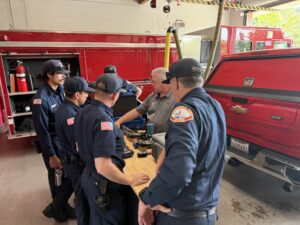Radiation Training for the City of Coronado Fire Department
Radiation Training for the City of Coronado Fire Department
CBRN HQ, in partnership with Radiation Emergency Safety Tactics (REST) LLC, conducted a comprehensive Personal Radiation Detector (PRD) Operations Review Course for the City of Coronado Fire Department in 2025. The training combined classroom instruction with realistic outdoor field exercises, ensuring participants gained both theoretical knowledge and hands-on operational skills.
Classroom Instruction
The indoor portion, supported by a tailored PowerPoint presentation, focused on:
- Ionizing Radiation Fundamentals – Types of ionizing radiation and the detection capabilities of PRDs.
- Source Identification – Differences between Naturally Occurring Radioactive Material (NORM), industrial sources, and nuclear materials.
- Safety Principles – The ALARA concept (Time, Distance, Shielding) and the Inverse Square Law.
- Isotopes of Concern – Profiles of common industrial, medical, and prohibited radioactive isotopes such as Cesium-137, Cobalt-60, Iridium-192, Americium-241, Plutonium-239, and Uranium-235, along with their potential threat forms (RDD, RED, nuclear weapons).
- Threat Awareness – Review of recent national incidents involving theft, accidental release, or attempted malicious use of radioactive materials.
Scenario-Based Discussions
Participants worked through realistic initial arrival scenarios, including:
- Transportation/package incidents involving radioactive materials.
- Explosion scenes with potential Radiological Dispersal Device (RDD) involvement.
- “Sick building” events with multiple casualties exhibiting acute radiation symptoms.
- These exercises emphasized rapid hazard recognition, PPE selection, and the use of guiding reference materials.
Hands-On Field Training
Following the classroom review, crews rotated through three progressive outdoor training formats:
- Static Exercises – Practicing PRD functionality checks, meter settings, and basic detection on fixed live or simulated sources.
- Dynamic Exercises – Active search drills involving small- and large-area sweeps, alarm resolution, and source pinpointing using the Inverse Square Law.
- PlumeSim Exercise – A simulated plume contamination scenario allowing responders to track, map, and manage a radiation release pattern in real time.
Key Outcomes
- Enhanced familiarity with PRD operation under both routine and emergency conditions.
- Improved confidence in identifying and differentiating radiation threats.
- Stronger coordination between classroom theory, field application, and real-world response expectations.
- Direct alignment of training content with the City of Coronado Fire Department’s operational needs and SOPs.





